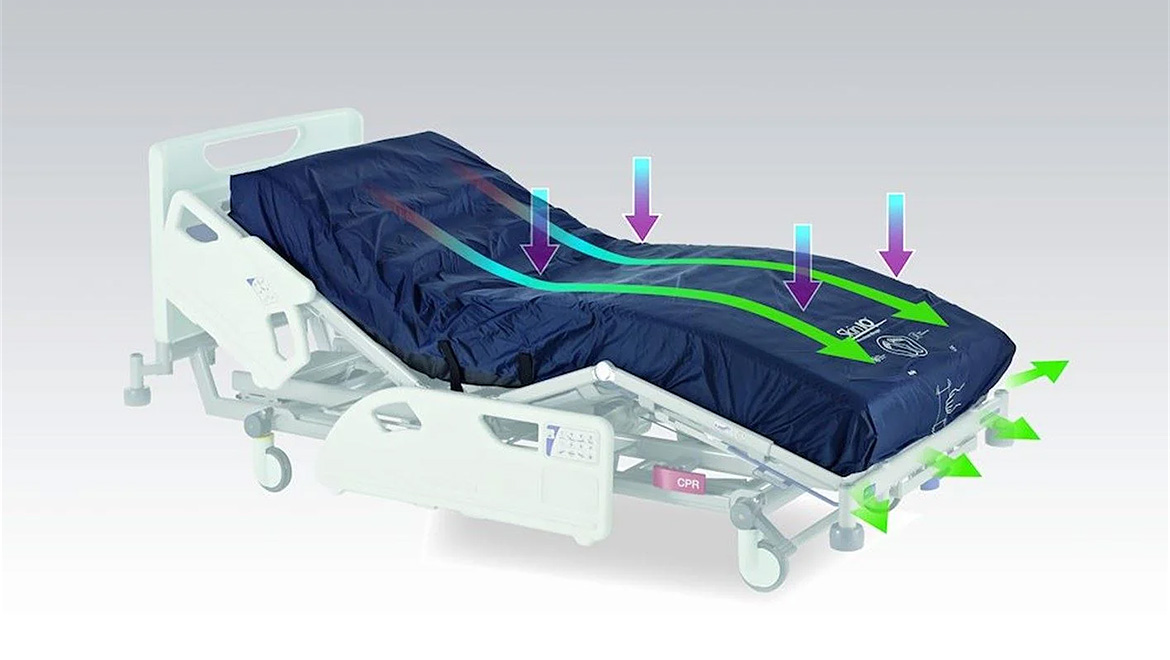PIP during the global pandemic: Prone Positioning
Pressure injuries are a preventable medical condition, usually caused by immobility in bedridden patients, developed by one out of two patients in acute care. Due to the excessive financial, economic and psychological cost of pressure injuries, there is considerable “pressure” on healthcare systems to reduce incidences of the condition.
While prone positioning, or lying the patient face-down (see Fig. 1), has been recommended since as far back as 19743 for treating ARDS, the recent COVID-19 pandemic has driven an increase in the necessity for and utilisation of prone positioning as a method to improve life-threatening low oxygen levels.

Figure 4: Adjusting the Wound Valves on a Nimbus Professional.
The Nimbus Professional mattress also offers the additional benefit of a fully-welded cover constructed from one of the toughest medical fabrics available7.
Extensive clinical studies8-15 on the Nimbus product range consistently demonstrate excellent outcomes for the most vulnerable patients or those with existing wounds.
Explore our Prone Positioning Solutions page or visit the Nimbus Professional page to learn more.
References
- Dardeir A, Marudhai S, Patel M, Ghani MR, Busa V. Factors Influencing Prone Positioning in Treating Acute Respiratory Distress Syndrome and the Effect on Mortality Rate. Cureus. 2020 Oct 2;12(10):e10767. doi: 10.7759/cureus.10767. PMID: 33033667; PMCID: PMC7532878.
- Koulouras V, Papathanakos G, Papathanasiou A, Nakos G. Efficacy of prone position in acute respiratory distress syndrome patients: A pathophysiology-based review. World J Crit Care Med. 2016 May 4;5(2):121-36. doi: 10.5492/wjccm.v5.i2.121. PMID: 27152255; PMCID: PMC4848155.
- Bryan AC, Conference on the scientific basis of respiratory therapy. Pulmonary physiotherapy in the pediatric age group. Comments of a devil’s advocate. Am Rev Respir Dis 1974; 110: 143–144.
- Papazian, L, Aubron, C, Brochard, L et al, 2019. Formal guidelines: management of acute respiratory distress syndrome. Annals of Intensive Care, 9(1).
- Girard R, Baboi L, et al The impact of patient positioning on pressure ulcers in patients with severe ARDS: results from a multicentre randomised controlled trial on prone positioning, Intensive Care Med (2014) 40:397–403 4.
- Bunker D, Thomson M, Chin Necrosis as a Consequence of Prone Positioning in the Intensive Care Unit Case Reports in Medicine Volume 2015, Article ID 762956.
- Dartex Coatings Limited, 2013. The Impact of Cleaning Chemicals on Polyurethane Mattress Cover Materials and their Propensity for Physical Damage. Authored by Jo Milnes MA(Hons), MSc(Dist), Technical Manager.
- Ward C, Wubbels M, Schembri L (2012) Using Complete Pressure Off-loading and Advanced Wound Care to Treat a Complex Sacral Pressure Ulcer. Poster Presentation.
- Clancy J (2011) Winning the war against pressure ulcers. Poster presentation.
- Malbrain M, Hendriks B, Wijnands P et al (2010) A pilot randomised controlled trial comparing reactive air and active alternating pressure mattresses in the prevention and treatment of pressure ulcers among medical ICU patients. Journal of Tissue Viability 19(1):7-15.
- Finnegan MJ (2008). Comparing the effectiveness of a specialised alternating air pressure mattress replacement system and an air fluidised integrated bed in the management of post- operative flap patients. A randomised controlled study. Journal of Tissue Viability 17(1): February 2008.
- Russell L, Reynolds TM (2000) Randomised controlled trial of two pressure relieving systems. Journal of Wound Care 9(2):52-55.
- Evans D, Land L, Geary A (2000). A clinical evaluation of the Nimbus 3 alternating pressure mattress replacement system. Journal of Wound Care 9(4):181-186.
- Land L, Evans D, Geary A et al (2000) A clinical evaluation of an alternating pressure mattress replacement system in hospital and residential care settings. Journal of Tissue Viability 10(1): 6-11
- Phillips L (2010) Nimbus range of pressure redistributing mattresses. Wounds UK, 2010, 6 (2): 116-122.


_Blog%20Image_PNG.png)


_Blog%20Image_PNG.png)